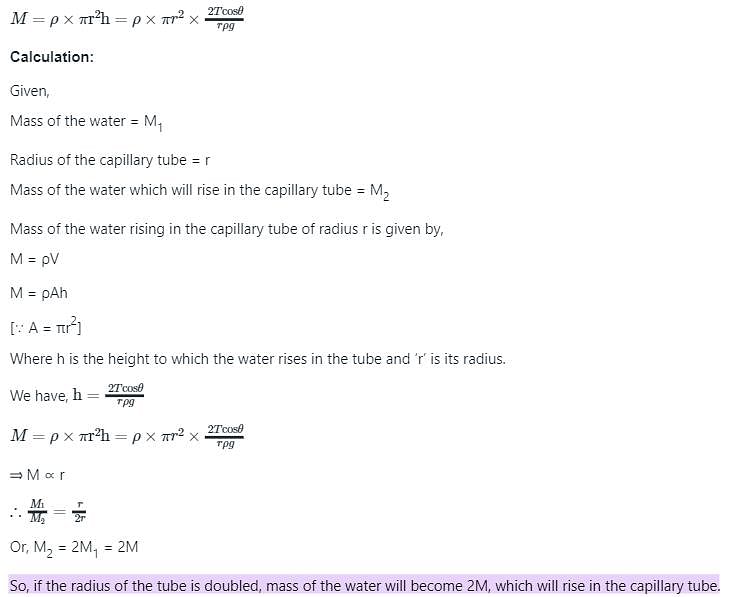JEE Exam > JEE Tests > Daily Test for JEE Preparation > Test: Viscosity & Surface Tension (22 August) - JEE MCQ
Test: Viscosity & Surface Tension (22 August) - JEE MCQ
Test Description
10 Questions MCQ Test Daily Test for JEE Preparation - Test: Viscosity & Surface Tension (22 August)
Test: Viscosity & Surface Tension (22 August) for JEE 2024 is part of Daily Test for JEE Preparation preparation. The Test: Viscosity & Surface Tension (22 August) questions and answers have been
prepared according to the JEE exam syllabus.The Test: Viscosity & Surface Tension (22 August) MCQs are made for JEE 2024 Exam. Find important
definitions, questions, notes, meanings, examples, exercises, MCQs and online tests for Test: Viscosity & Surface Tension (22 August) below.
Solutions of Test: Viscosity & Surface Tension (22 August) questions in English are available as part of our Daily Test for JEE Preparation for JEE & Test: Viscosity & Surface Tension (22 August) solutions in
Hindi for Daily Test for JEE Preparation course. Download more important topics, notes, lectures and mock
test series for JEE Exam by signing up for free. Attempt Test: Viscosity & Surface Tension (22 August) | 10 questions in 20 minutes | Mock test for JEE preparation | Free important questions MCQ to study Daily Test for JEE Preparation for JEE Exam | Download free PDF with solutions
Test: Viscosity & Surface Tension (22 August) - Question 1
Fluids offer resistance to motion due to internal friction, this property is called?
Detailed Solution for Test: Viscosity & Surface Tension (22 August) - Question 1
Test: Viscosity & Surface Tension (22 August) - Question 2
The friction in a flowing fluid is called ________.
Detailed Solution for Test: Viscosity & Surface Tension (22 August) - Question 2
| 1 Crore+ students have signed up on EduRev. Have you? Download the App |
Test: Viscosity & Surface Tension (22 August) - Question 3
Consider the following:
Water is more viscous than blood.
Blood is more viscous than water.
They cannot be compared.
Which of the above is the best relation between the viscosities of blood and water?
Detailed Solution for Test: Viscosity & Surface Tension (22 August) - Question 3
Test: Viscosity & Surface Tension (22 August) - Question 4
Two capillary tubes of different diameters are dipped in water. The rise of water is _______
Detailed Solution for Test: Viscosity & Surface Tension (22 August) - Question 4
Test: Viscosity & Surface Tension (22 August) - Question 5
Which one of the following affects the efficiency of oil transportation through a pipeline?
Detailed Solution for Test: Viscosity & Surface Tension (22 August) - Question 5
Test: Viscosity & Surface Tension (22 August) - Question 6
The viscosity of gases increases with:
Detailed Solution for Test: Viscosity & Surface Tension (22 August) - Question 6
Test: Viscosity & Surface Tension (22 August) - Question 7
A water drop is divided into 27 equal droplets. The pressure difference between the inner and outer side of the big drop will be:
Detailed Solution for Test: Viscosity & Surface Tension (22 August) - Question 7
Test: Viscosity & Surface Tension (22 August) - Question 8
On dipping a capillary in water, the mass of the water that rises in it is 'm'. If another capillary of double the radius of the first is dipped into the water, the mass of water risen will be:
Detailed Solution for Test: Viscosity & Surface Tension (22 August) - Question 8
Test: Viscosity & Surface Tension (22 August) - Question 9
The rise of a liquid in a capillary tube is due to:
Detailed Solution for Test: Viscosity & Surface Tension (22 August) - Question 9
Test: Viscosity & Surface Tension (22 August) - Question 10
Dancing of small pieces of camphor on the surface of water is due to:
Detailed Solution for Test: Viscosity & Surface Tension (22 August) - Question 10
|
360 tests
|
Information about Test: Viscosity & Surface Tension (22 August) Page
In this test you can find the Exam questions for Test: Viscosity & Surface Tension (22 August) solved & explained in the simplest way possible.
Besides giving Questions and answers for Test: Viscosity & Surface Tension (22 August), EduRev gives you an ample number of Online tests for practice


















